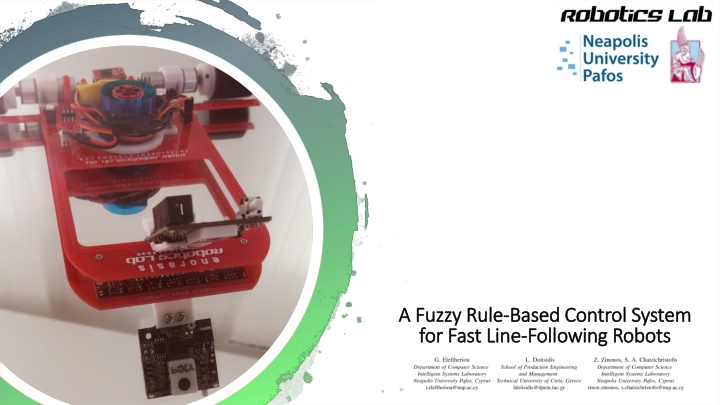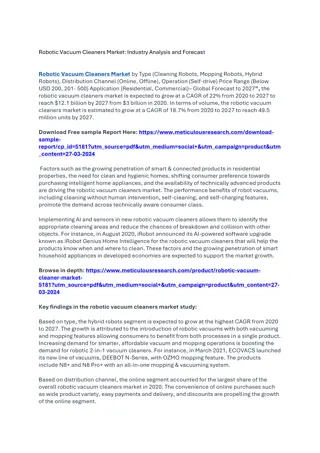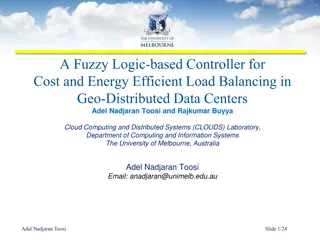Fuzzy Rule-Based Control System for Fast Line-Following Robots
This paper discusses the optimization of line-tracking and following control techniques in high-speed autonomous IoT devices such as line-following robotic vehicles. It introduces a proactive feed-forward control system utilizing computer vision and an array of analog infrared reflective phototransistors with an optimized PID-based feedback implementation. The proposed navigation algorithm combines PID control with a visual system using a Fuzzy Rule-Based approach to enhance tracking performance, especially in fast non-linear deviations.
Download Presentation

Please find below an Image/Link to download the presentation.
The content on the website is provided AS IS for your information and personal use only. It may not be sold, licensed, or shared on other websites without obtaining consent from the author.If you encounter any issues during the download, it is possible that the publisher has removed the file from their server.
You are allowed to download the files provided on this website for personal or commercial use, subject to the condition that they are used lawfully. All files are the property of their respective owners.
The content on the website is provided AS IS for your information and personal use only. It may not be sold, licensed, or shared on other websites without obtaining consent from the author.
E N D
Presentation Transcript
A Fuzzy Rule A Fuzzy Rule- -Based Control System Based Control System for Fast Line for Fast Line- -Following Robots Following Robots
A Fuzzy Rule-Based Control System for Fast Line-Following Robots This paper focuses on the optimization of the line-tracking and following control technique used in high speed autonomous movable IoT devices such as line-following robotic vehicles. A fusion of a new pro-active / feed-forward control system, based on the simultaneous use of computer vision and the use of an array of analog infrared reflective phototransistors with an optimised PID based feed- back implementation is proposed. Proportional Integral Derivative (PID) New An Computer Vision Navigation Technique Autonomous Robot
The Custom Line-Following Robot To highlight the proposed approach a custom robotic vehicle was developed. We have used off-the-shelf components aiming on developing a low cost, very low computationally demanding, agile lightweight vehicle (less than 0.5 kg), capable of performing autonomous navigation by fusing the information from different sensors and processing it on board, using a lightweight algorithm that can be used in any kind of similar or up-scaled platform.
The Custom Line-Following Robot To highlight the proposed approach a custom robotic vehicle was developed. For the data acquisition a Pololu QTR-8A Analog Infrared-reflective phototransistor 8 sensor array and a Charmed Labs Pixy2 camera were used. For the differential drive system 2x16mm 12-volt 5000 RPM DC motors, with a stall current of 2.5 Amps each were integrated. To optimally align the chosen components we`ve designed and manufactured a custom Printed Circuit Board (PCB) The core of the system is an Arduino NANO board with a low end 16MHz ATmega328P microcontroller.
Proposed Navigation Algorithm The overall PID control function can be expressed mathematically as : A PID-only controller can be used to robustly track and follow simple paths up to speeds of around 1 meter per second. In several cases, the classical PID controller leads to line loss due to extreme changes in the path curvature. One can visualize how the PID-only controller, due to its feedback dependency, can suffer from accidental line loss.
Proposed Navigation Algorithm We propose a new algorithm that combines the advantages of the PID with the benefits of a visual system using a Fuzzy Ruled-Based approach. Our proposed method strives to correct these limitations by adding an anticipatory control, via the addition of an input from a new feed- forward system that can greatly enhance the ability of the PID controller to react timely in fast non-linear deviations from the set-point. Several researchers have proposed applying a visual system to autonomous vehicles to capture and analyze the visual images to overcome the limitations of other sensors The ability to be pro- active can aid in the manipulation of the speed of the line- following vehicle
Proposed Navigation Algorithm We propose a new algorithm that combines the advantages of the PID with the benefits of a visual system using a Fuzzy Ruled-Based approach. Consider a robot towards achieving the objective of line-following. For ease of understanding, it is assumed the augmented decision vector: F1 takes into account only the IR array measurements while F2 considers only the camera's measurements. In general, the proposed method follows F1 to manipulate the steering parameters, while F2 manipulates the speed parameters of the robot and selects an optimal set of Kp, Ki, Kd parameters for the desired speed. The optimal Xk vector in the proposed control strategy can be straightforwardly derived from:
Proposed Navigation Algorithm We propose a new algorithm that combines the advantages of the PID with the benefits of a visual system using a Fuzzy Ruled-Based approach. F1 uses as input the infrared reflective phototransistors' measurements and in the case of absence of input from the camera, based on a traditional PID controller, calculates safe steering and speed parameters. In the presence of input from the camera F2 selects a more suitable set of PID parameters and speed for various cases and lengths of line.
Proposed Navigation Algorithm We propose a new algorithm that combines the advantages of the PID with the benefits of a visual system using a Fuzzy Ruled-Based approach. To visually detect the position and the length of the line, the proposed architecture uses a Pixy2 vision sensor. In our implementation, the output of the F2 is based on a fuzzy interface. The first input of the fuzzy system X1 corresponds to the current maximum speed of the motors. Our algorithm identifies all the other lines in the image and calculates their intersection point The second input of the fuzzy system X2 is related with the length of the detected line.
Proposed Navigation Algorithm We propose a new algorithm that combines the advantages of the PID with the benefits of a visual system using a Fuzzy Ruled-Based approach. A set of triangular membership functions fuzzifies each X score. Sequentially, the fuzzy inputs are combined using a list of 6 rules for producing the fuzzy output of the system. The final crisp output is produced using the centroid defuzzification method. F2 shapes on the one hand the basic speed of the robot at each iteration while on the other hand provides the optimal Kp, Ki and Kd parameters for F1.
Experimental Setup Experiments were conducted on a track of a black line on a white surface. The track was designed and printed on a 300X300 cm glossy PVC material, so it could be as slippery as possible. The total black line (path) length was 20m long. The path was selected to be as close to real-world applications, consisting of complex line structures such as acute turns, intersections, a loop and at places single or consecutive 90 degree turns. To evaluate the proposed methodology we constructed 4 identical systems: A traditional PID line-following algorithm navigation robot, a PID with an EDF line-following robot, the proposed method navigation robot and the proposed method navigation robot with an EDF.
Achievements The Robot won the Line- Following Classic (without EDF) challenge during the ROBOTEX- CY 2019 competition in the Universities category took a 3rd place in the Line- Following challenge during the International Robotics Competition ROBOTEX INTERNATIONAL 2019 in Estonia took a 1st and 2nd place in the Line-Following Turbo challenge (with EDF) during the 2020 XII INTERNATIONAL ROBOTIC ARENA in Poland
Youtube Videos Youtube Videos
Thank you Thank you























